You have an Azure Machine Learning workspace
You plan to use the Azure Machine Learning SDK for Python v1 to submit a job to run a training script.
You need to complete the script to ensure that it will execute the training script.
How should you complete the script? To answer, select the appropriate options in the answer area.
NOTE: Each correct selection is worth one point
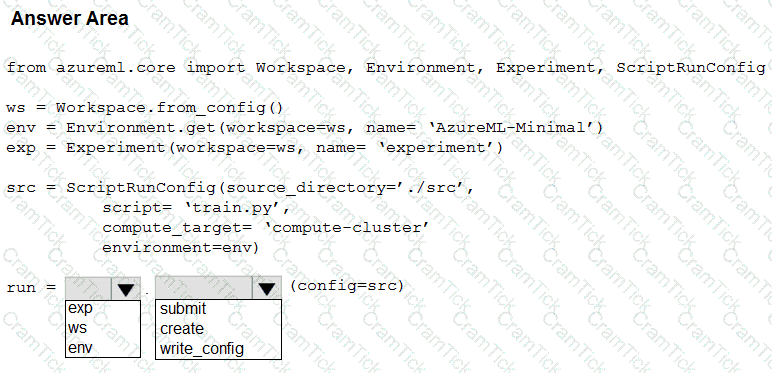
You manage an Azure Al Foundry project. You fine-tune the base model
During evaluation, you observe that the model is overfitting and its responses are highly varying
You need to improve the fine-tuned model.
Which hyperparameters should you use? To answer, move the appropriate hyper para meters to the correct requirements. You may use each hyperparameter once, more than once, or not at all. You may need to move the split bar between panes or scroll to view content
NOTE: Each correct selection is worth one point.

You register a file dataset named csvjolder that references a folder. The folder includes multiple com ma-separated values (CSV) files in an Azure storage blob container. You plan to use the following code to run a script that loads data from the file dataset. You create and instantiate the following variables:

You have the following code:


You need to pass the dataset to ensure that the script can read the files it references. Which code segment should you insert to replace the code comment?
A)

B)

C)

D)

You create a multi-class image classification deep learning experiment by using the PyTorch framework. You plan to run the experiment on an Azure Compute cluster that has nodes with GPU’s.
You need to define an Azure Machine Learning service pipeline to perform the monthly retraining of the image classification model. The pipeline must run with minimal cost and minimize the time required to train the model.
Which three pipeline steps should you run in sequence? To answer, move the appropriate actions from the list of actions to the answer area and arrange them in the correct order.
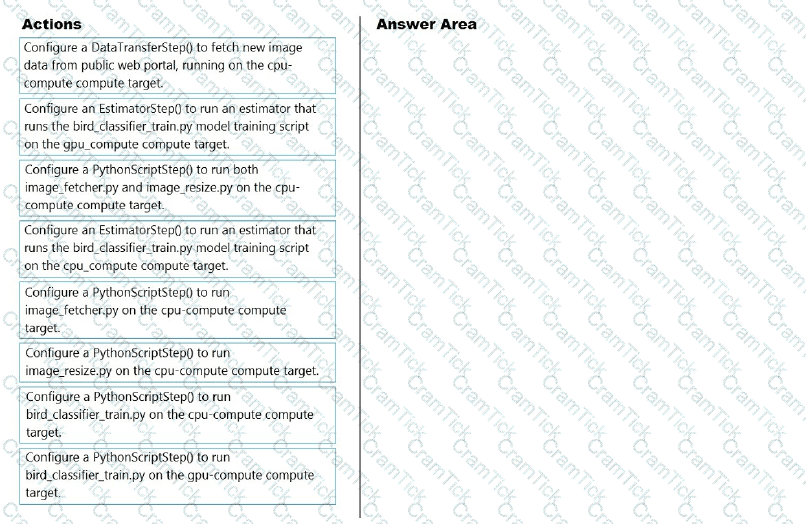
You are developing a machine learning solution by using the Azure Machine Learning designer.
You need to create a web service that applications can use to submit data feature values and retrieve a predicted label.
Which three actions should you perform in sequence? To answer, move the appropriate actions from the list of actions to the answer area and arrange them in the correct order.

You use Azure Machine Learning designer to create a real-time service endpoint. You have a single Azure Machine Learning service compute resource. You train the model and prepare the real-time pipeline for deployment You need to publish the inference pipeline as a web service. Which compute type should you use?
You manage an Azure Machine Learning workspace. The development environment is configured with a Serverless Spark compute in Azure Machine Learning Notebooks.
You perform interactive data wrangling to clean up the Titanic dataset and store it as a new dataset (Line numbers are used for reference only.)

For each of the following statements, select Yes if the statement is true Otherwise, select No
NOTE: Bach correct selection is worth one point.

An organization creates and deploys a multi-class image classification deep learning model that uses a set of labeled photographs.
The software engineering team reports there is a heavy inferencing load for the prediction web services during the summer. The production web service for the model fails to meet demand despite having a fully-utilized compute cluster where the web service is deployed.
You need to improve performance of the image classification web service with minimal downtime and minimal administrative effort.
What should you advise the IT Operations team to do?
You are designing an Azure Machine Learning solution for traffic optimization.
The model must be deployed as a web service on a serverless compute and provide real-time predictions based on current traffic and weather conditions. You need to choose an inferencing strategy for the solution. Which compute should you use?
You are building an experiment using the Azure Machine Learning designer.
You split a dataset into training and testing sets. You select the Two-Class Boosted Decision Tree as the algorithm.
You need to determine the Area Under the Curve (AUC) of the model.
Which three modules should you use in sequence? To answer, move the appropriate modules from the list of modules to the answer area and arrange them in the correct order.
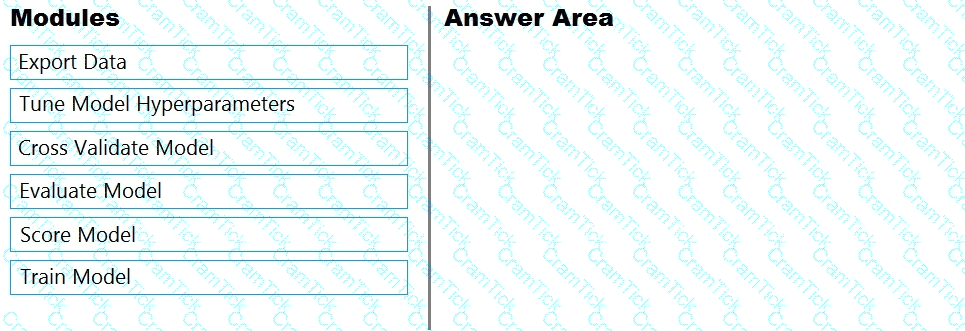
You are evaluating a Python NumPy array that contains six data points defined as follows:
data = [10, 20, 30, 40, 50, 60]
You must generate the following output by using the k-fold algorithm implantation in the Python Scikit-learn machine learning library:
train: [10 40 50 60], test: [20 30]
train: [20 30 40 60], test: [10 50]
train: [10 20 30 50], test: [40 60]
You need to implement a cross-validation to generate the output.
How should you complete the code segment? To answer, select the appropriate code segment in the dialog box in the answer area.
NOTE: Each correct selection is worth one point.
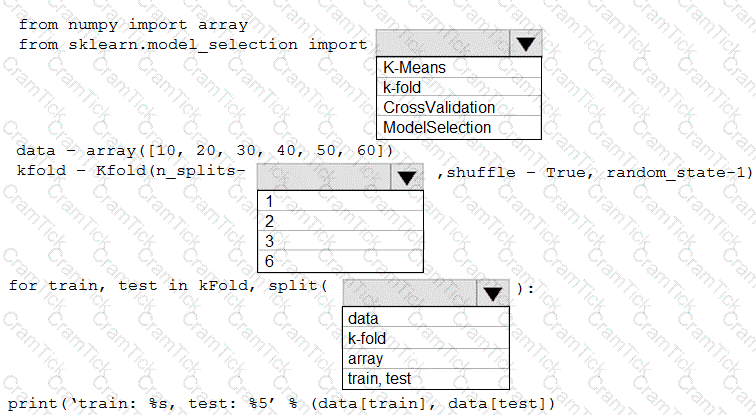
You have an Azure Machine Learning workspace named Workspace^ Workspace1 has a registered MLflow model named model1 with PyFunc flavor. You plan to deploy model1 to an online endpoint named endpoint1 without egress connectivity by using Azure Machine Learning Python SDK v2. You have the following code:
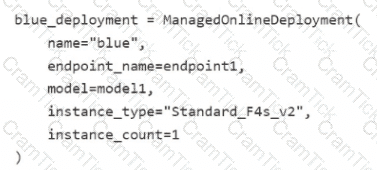
You need to add a parameter to the ManagedOnlineDeployment object to ensure the model deploys successfully.
Solution: Add the code_path parameter.
Does the solution meet the goal?
You have an Azure Machine Learning workspace named Workspace 1 Workspace! has a registered Mlflow model named model 1 with PyFunc flavor
You plan to deploy model1 to an online endpoint named endpointl without egress connectivity by using Azure Machine learning Python SDK vl
You have the following code:
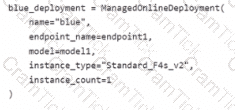
You need to add a parameter to the ManagedOnllneDeployment object to ensure the model deploys successfully
Solution: Add the with_package parameter.
Does the solution meet the goal?
An organization uses Azure Machine Learning service and wants to expand their use of machine learning.
You have the following compute environments. The organization does not want to create another compute environment.

You need to determine which compute environment to use for the following scenarios.
Which compute types should you use? To answer, drag the appropriate compute environments to the correct scenarios. Each compute environment may be used once, more than once, or not at all. You may need to drag the split bar between panes or scroll to view content.
NOTE: Each correct selection is worth one point.

You are building an intelligent solution using machine learning models.
The environment must support the following requirements:
Data scientists must build notebooks in a cloud environment
Data scientists must use automatic feature engineering and model building in machine learning pipelines.
Notebooks must be deployed to retrain using Spark instances with dynamic worker allocation.
Notebooks must be exportable to be version controlled locally.
You need to create the environment.
Which four actions should you perform in sequence? To answer, move the appropriate actions from the list of actions to the answer area and arrange them in the correct order.
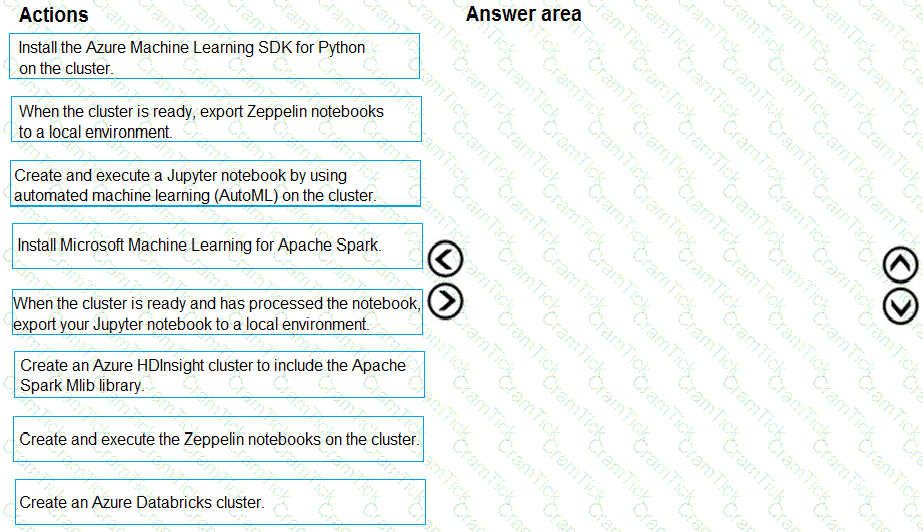
You are building a machine learning model for translating English language textual content into French
language textual content.
You need to build and train the machine learning model to learn the sequence of the textual content.
Which type of neural network should you use?
Note: This question is part of a series of questions that present the same scenario. Each question in the series contains a unique solution that might meet the stated goals. Some question sets might have more than one correct solution, while others might not have a correct solution.
After you answer a question in this section, you will NOT be able to return to it. As a result, these
questions will not appear in the review screen.
You are creating a model to predict the price of a student’s artwork depending on the following variables: the student’s length of education, degree type, and art form.
You start by creating a linear regression model.
You need to evaluate the linear regression model.
Solution: Use the following metrics: Accuracy, Precision, Recall, F1 score and AUC.
Does the solution meet the goal?
Note: This question is part of a series of questions that present the same scenario. Each question in the series contains a unique solution that might meet the stated goals. Some question sets might have more than one correct solution, while others might not have a correct solution.
After you answer a question in this section, you will NOT be able to return to it. As a result, these questions will not appear in the review screen.
You have a Python script named train.py in a local folder named scripts. The script trains a regression model by using scikit-learn. The script includes code to load a training data file which is also located in the scripts folder.
You must run the script as an Azure ML experiment on a compute cluster named aml-compute.
You need to configure the run to ensure that the environment includes the required packages for model training. You have instantiated a variable named aml-compute that references the target compute cluster.
Solution: Run the following code:

Does the solution meet the goal?
You are retrieving data from a large datastore by using Azure Machine Learning Studio.
You must create a subset of the data for testing purposes using a random sampling seed based on the system clock.
You add the Partition and Sample module to your experiment.
You need to select the properties for the module.
Which values should you select? To answer, select the appropriate options in the answer area.
NOTE: Each correct selection is worth one point.
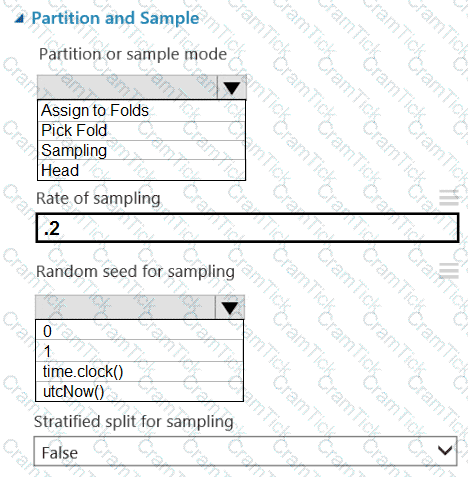
You use Azure Machine Learning to tram a model.
You must use Baylean sampling to Tune hyperparaters.
You need to select a learning_rate parameter distribution.
Which two distributions can you use? Each correct answer presents a complete solution.
NOTE Each correct selection is worth one point.
You need to replace the missing data in the AccessibilityToHighway columns.
How should you configure the Clean Missing Data module? To answer, select the appropriate options in the answer area.
NOTE: Each correct selection is worth one point.
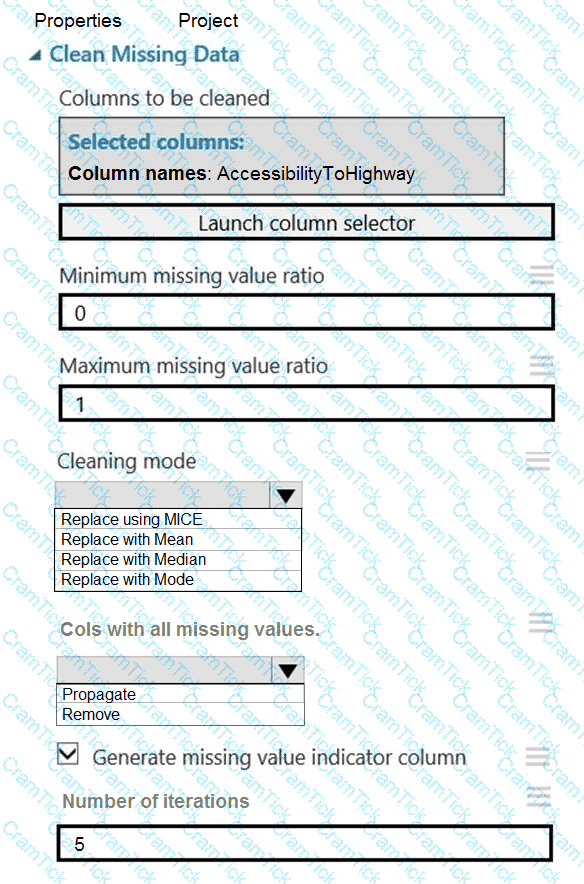
You are solving a classification task.
You must evaluate your model on a limited data sample by using k-fold cross validation. You start by
configuring a k parameter as the number of splits.
You need to configure the k parameter for the cross-validation.
Which value should you use?
You need to identify the methods for dividing the data according, to the testing requirements.
Which properties should you select? To answer, select the appropriate option-, m the answer area. NOTE: Each correct selection is worth one point.
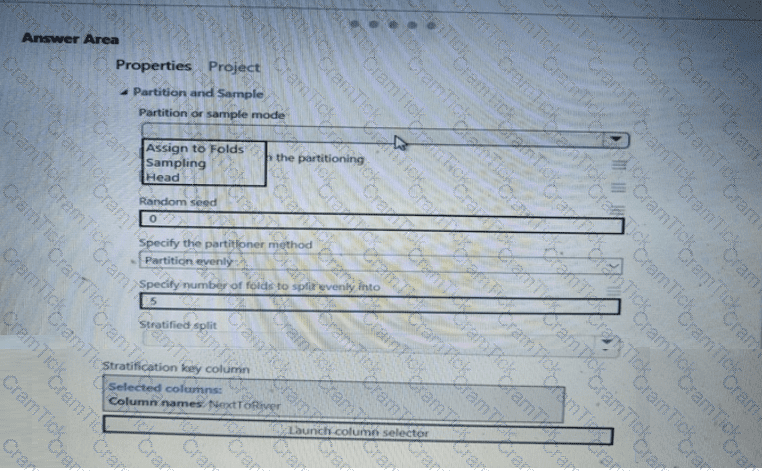
You need to identify the methods for dividing the data according to the testing requirements.
Which properties should you select? To answer, select the appropriate options in the answer area.
NOTE: Each correct selection is worth one point.
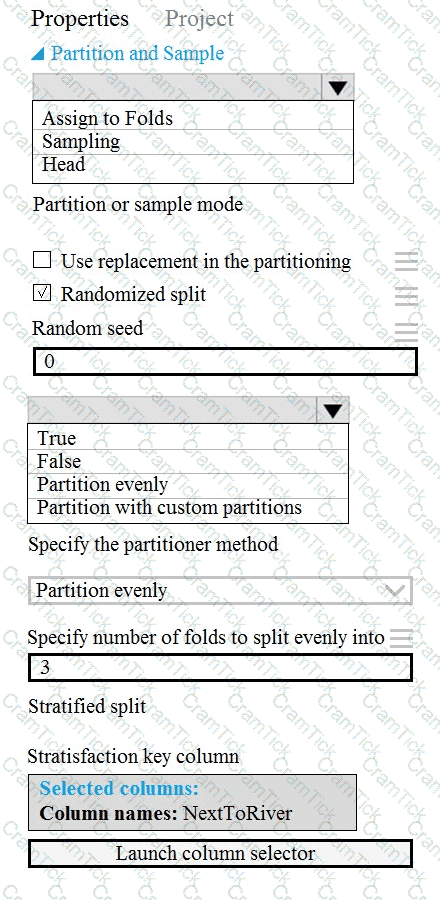
You need to configure the Feature Based Feature Selection module based on the experiment requirements and datasets.
How should you configure the module properties? To answer, select the appropriate options in the dialog box in the answer area.
NOTE: Each correct selection is worth one point.
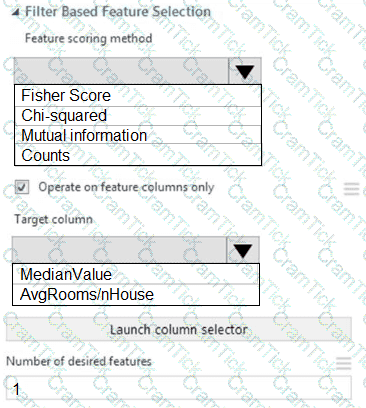
You need to set up the Permutation Feature Importance module according to the model training requirements.
Which properties should you select? To answer, select the appropriate options in the answer area.
NOTE: Each correct selection is worth one point.
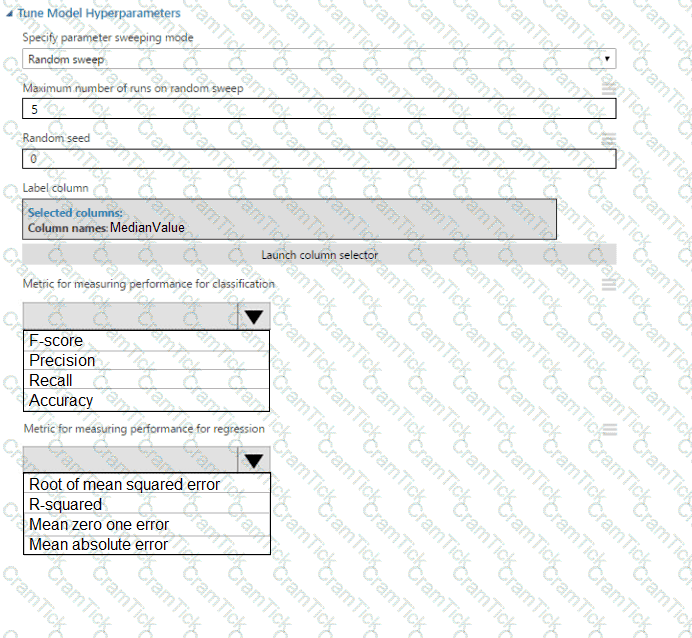
You need to visually identify whether outliers exist in the Age column and quantify the outliers before the outliers are removed.
Which three Azure Machine Learning Studio modules should you use in sequence? To answer, move the appropriate modules from the list of modules to the answer area and arrange them in the correct order.
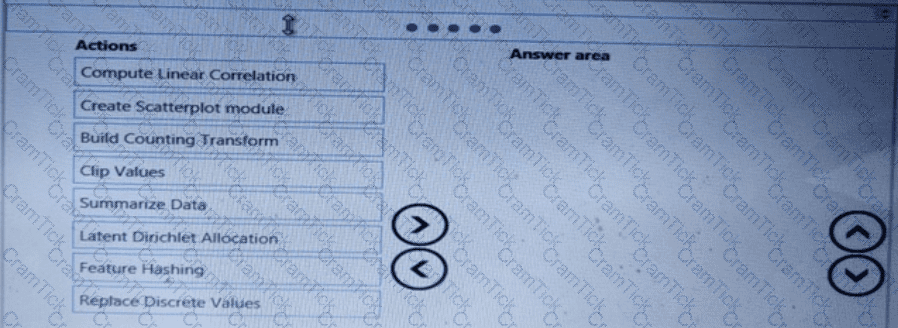
You need to configure the Edit Metadata module so that the structure of the datasets match.
Which configuration options should you select? To answer, select the appropriate options in the answer area.
NOTE: Each correct selection is worth one point.
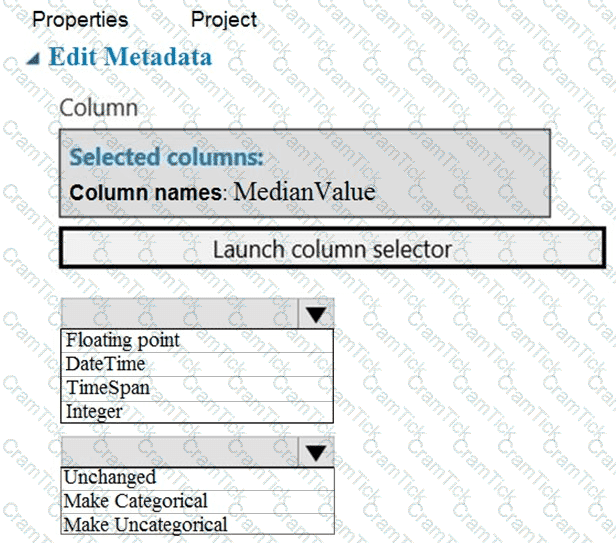
You need to configure the Permutation Feature Importance module for the model training requirements.
What should you do? To answer, select the appropriate options in the dialog box in the answer area.
NOTE: Each correct selection is worth one point.
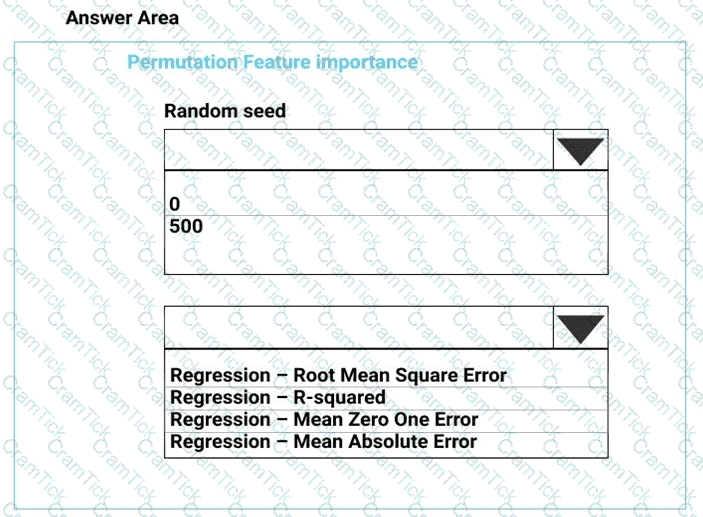
You need to produce a visualization for the diagnostic test evaluation according to the data visualization requirements.
Which three modules should you recommend be used in sequence? To answer, move the appropriate modules from the list of modules to the answer area and arrange them in the correct order.
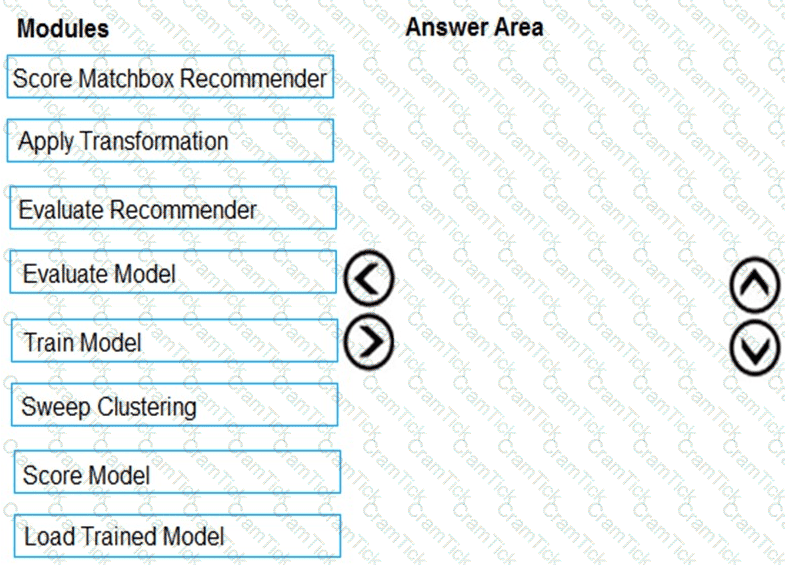
You need to correct the model fit issue.
Which three actions should you perform in sequence? To answer, move the appropriate actions from the list of actions to the answer area and arrange them in the correct order.
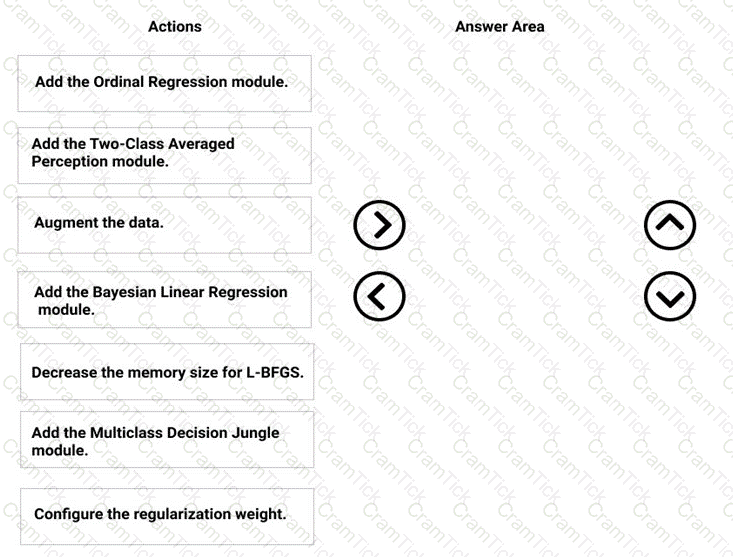
You need to implement early stopping criteria as suited in the model training requirements.
Which three code segments should you use to develop the solution? To answer, move the appropriate code segments from the list of code segments to the answer area and arrange them in the correct order.
NOTE: More than one order of answer choices is correct. You will receive credit for any of the correct orders you select.
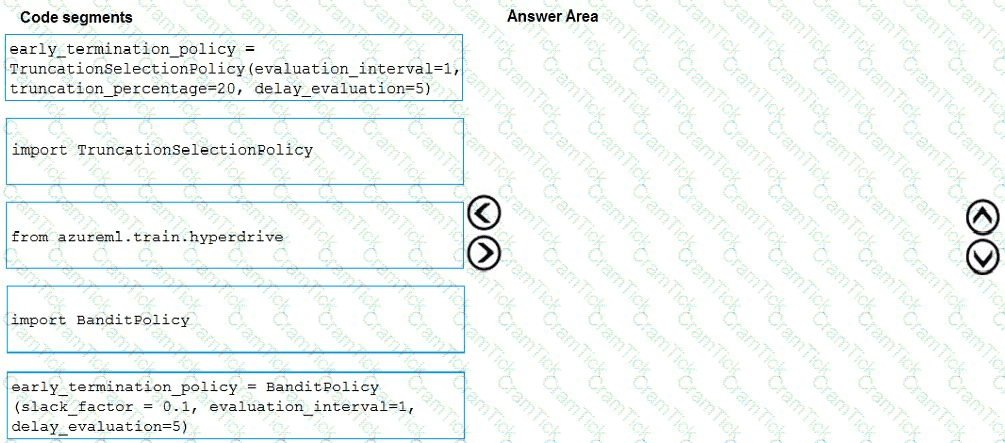
You need to define a process for penalty event detection.
Which three actions should you perform in sequence? To answer, move the appropriate actions from the list of actions to the answer area and arrange them in the correct order.
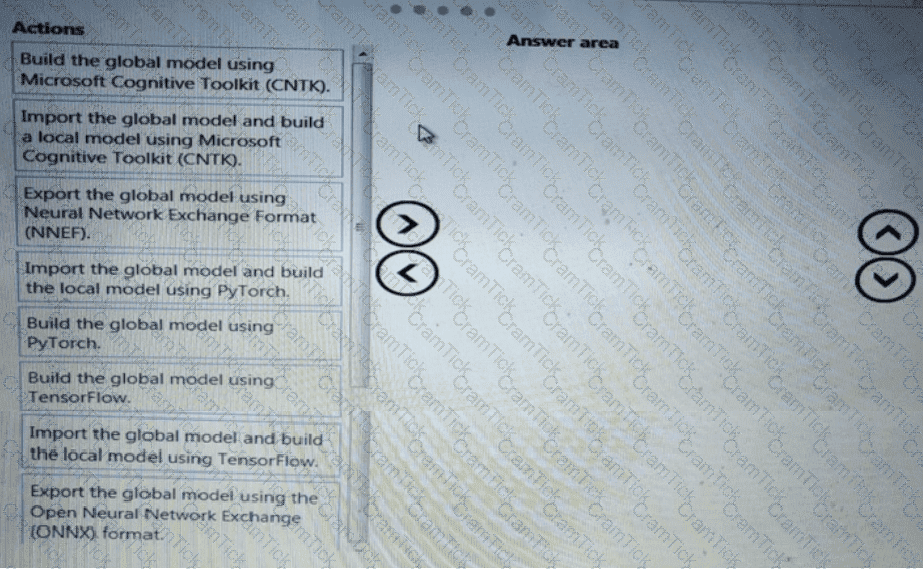
You need to modify the inputs for the global penalty event model to address the bias and variance issue.
Which three actions should you perform in sequence? To answer, move the appropriate actions from the list of actions to the answer area and arrange them in the correct order.
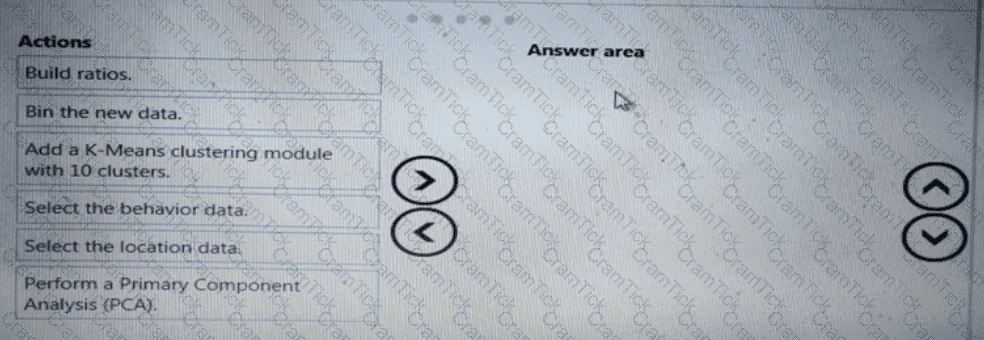
You need to implement a new cost factor scenario for the ad response models as illustrated in the
performance curve exhibit.
Which technique should you use?
You need to define a process for penalty event detection.
Which three actions should you perform in sequence? To answer, move the appropriate actions from the list of actions to the answer area and arrange them in the correct order.
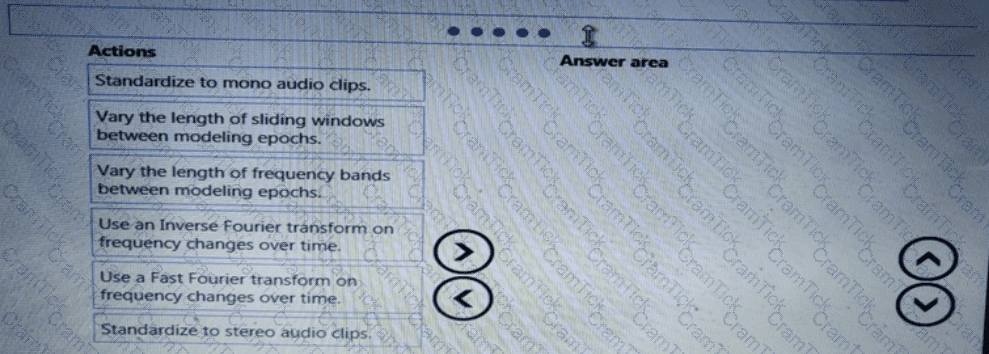
You need to implement a model development strategy to determine a user’s tendency to respond to an ad.
Which technique should you use?
You need to implement a feature engineering strategy for the crowd sentiment local models.
What should you do?
You need to define a modeling strategy for ad response.
Which three actions should you perform in sequence? To answer, move the appropriate actions from the list of actions to the answer area and arrange them in the correct order.
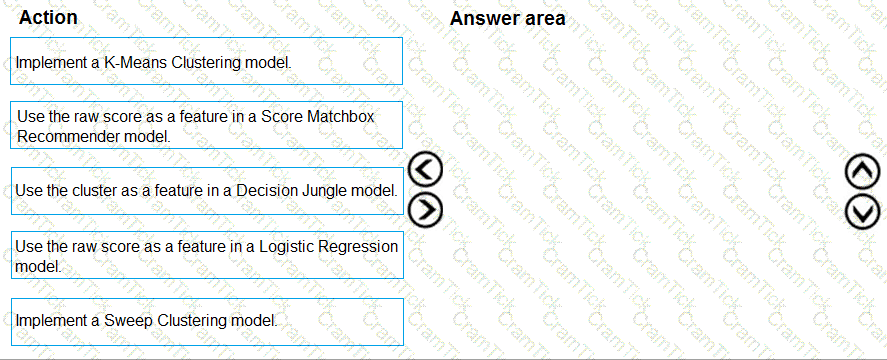
You need to select an environment that will meet the business and data requirements.
Which environment should you use?
You need to define an evaluation strategy for the crowd sentiment models.
Which three actions should you perform in sequence? To answer, move the appropriate actions from the list of actions to the answer area and arrange them in the correct order.
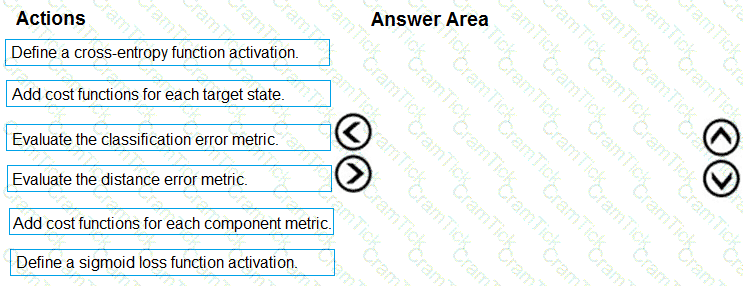
You need to define an evaluation strategy for the crowd sentiment models.
Which three actions should you perform in sequence? To answer, move the appropriate actions from the list of actions to the answer area and arrange them in the correct order.
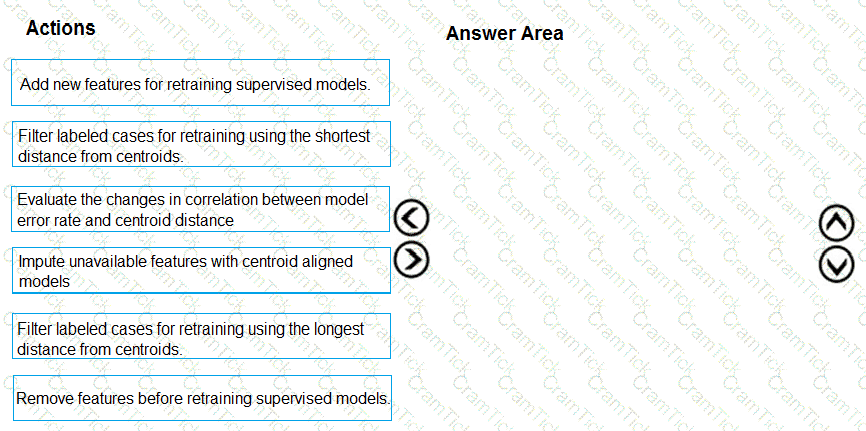
You need to build a feature extraction strategy for the local models.
How should you complete the code segment? To answer, select the appropriate options in the answer area.
NOTE: Each correct selection is worth one point.
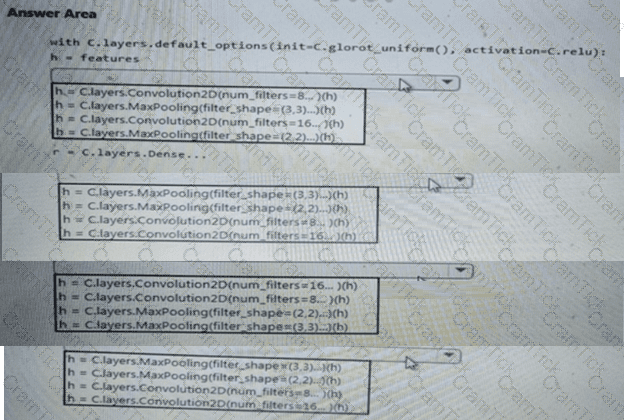
You need to use the Python language to build a sampling strategy for the global penalty detection models.
How should you complete the code segment? To answer, select the appropriate options in the answer area.
NOTE: Each correct selection is worth one point.
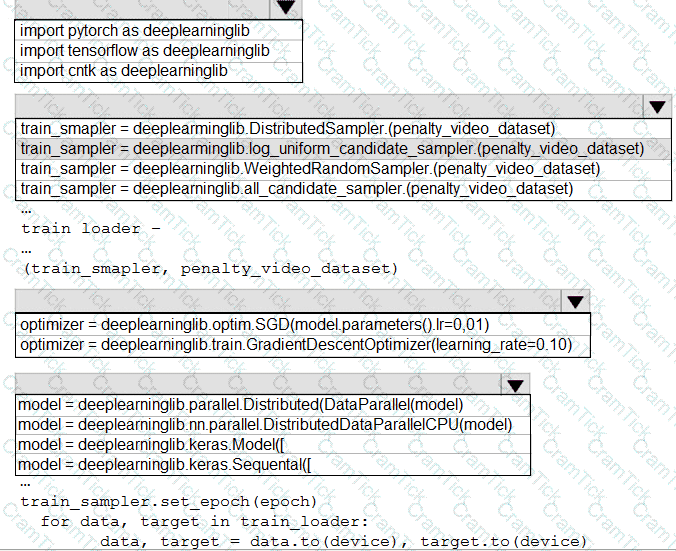
You need to implement a scaling strategy for the local penalty detection data.
Which normalization type should you use?
You need to resolve the local machine learning pipeline performance issue. What should you do?
Microsoft Azure | DP-100 Exam Topics | DP-100 Questions answers | DP-100 Test Prep | Designing and Implementing a Data Science Solution on Azure Exam Questions PDF | DP-100 Online Exam | DP-100 Practice Test | DP-100 PDF | DP-100 Test Questions | DP-100 Study Material | DP-100 Exam Preparation | DP-100 Valid Dumps | DP-100 Real Questions | Microsoft Azure DP-100 Exam Questions


